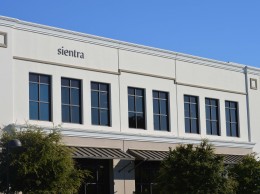Updated Sept. 16 at 2:30 p.m.:
Venoco has proposed to bring an early end to its offshore oil and gas production if the company’s Lease Line Adjustment Project is approved.
Denver-based Venoco, which has significant operations in Santa Barbara County, proposed on Sept. 16 that it would hand its offshore oil leases back to the state and retire Platform Holly in the Santa Barbara Channel and its Ellwood Onshore Facility in Goleta about 15 years ahead of schedule.
The announcement launches what’s expected to be a hotly contested battle over the future of Venoco’s operations in the South Coast. Goleta, Santa Barbara County, state and federal agencies all will play a role in the outcome.
Adjusting the lease line would allow the company to more efficiently extract the remaining oil in the South Ellwood Field without having to extend the life of the wells, Chief Operations Officer Mike Wracher told the Business Times in an interview.
Platform Holly would be retired 25 years after the LLA production begins instead of the initial 40-year timeline. Currently, Venoco’s offshore oil leases have no set termination date. Venoco emerged from bankruptcy reorganization this summer under ownership of Apollo Global Management.
Venoco aims to draw an additional 60 million barrels of oil from wells already in place on Platform Holly by amending its lease with the state, known as the LLA Project. An extension would allow the company to drill further east into six existing wells in the South Ellwood Oil Fields about 2 miles in state waters off the Santa Barbara Coast. It strives to change its lease to include 3,400 acres in exchange for releasing 3,800 acres in other portions of nearby leases to the California Coastal Sanctuary, according the company’s application.
Venoco would not need to develop new infrastructure to drill and thus wouldn’t pose any new environmental impacts, the company said. It would pump oil within the permitted limits of extraction without using hydraulic fracturing techniques, Venoco said.
“The existing LLA proposal already provides a number of important benefits to the local community and the state of California: good jobs, hundreds of millions of dollars in revenue for state and local governments, and the more effective and efficient recovery of the state’s oil and gas reserves without any new infrastructure,” Wracher said in a news release. “At the same time, we recognize that California’s goal is to move toward more renewable energy in the coming years.”
The Ellwood Onshore Facility would terminate the same time as Platform Holly, under the new proposal. Venoco would permanently quitclaim all of its leases in the South Ellwood Field and they could be protected as a marine sanctuary. It would also quitclaim all of Venoco’s Paredon oil and gas leases in an oil field off of the Carpinteria Coast, ensuring that more than 20 million barrels of oil and gas stay in the ground, the company said.
Company officials claim increased oil production at Platform Holly via the LLA Project would result in reduced greenhouse gas emissions. UC Santa Barbara studies found that the seeps within 1 mile of Platform Holly have been reduced by 80 percent since production started, which has limited methane gas emissions. All LLA-related operations would be carbon-neutral, Venoco said.
Critics of the project argue that the project poses significant environmental impacts, especially given the consequences of the recent Refugio oil spill.
The total project cost is estimated to be about $150 million to $175 million to complete.
The California State Land’s Commission released a Draft Environmental Impact Report on the LLA Project on Sept. 16. It included an alternative plan involving the construction of a 10.6 mile offshore subsea pipeline that would transport oil to Las Flores Canyon for processing rather than the Ellwood Onshore Facility. There is a 60-day public comment period for the LLA proposal.
The city of Goleta will hold a public discussion on Sept. 20 regarding the status of Venoco’s Ellwood Onshore Facility, which processes oil and gas produced from Platform Holly. The city can take formal action after Venoco’s bankruptcy stay is lifted.
Venoco filed for Chapter 11 bankruptcy protection in March and its restructuring plan was approved in July, enabling it to get out from under $1 billion of debt it incurred since oil prices plummeted and Plains All American Pipeline’s Line 901 and Line 903 were shut down following the Refugio oil spill in May 2015.
Apollo Global Management now has a 98 percent ownership stake in the company.
Goleta adopted a termination ordinance that would change the Ellwood Onshore Facility’s legal nonconforming use. It also challenged the CSLC’s 2014 approval to resume production at its PRC 421 facility just outside of Sandpiper Golf Course in Goleta. The litigation is ongoing.
The Venoco offer is a step in the right direction, but 25 years is too long for the Ellwood Onshore Facility to remain open, said Goleta City Councilman Tony Vallejo.
“I support the end to oil processing at the Ellwood Onshore Facility, but there are unanswered questions,” Vallejo said in a news release. “We must reduce the timeline to retirement of the facility and ensure the abandonment of the additional coastal oil lease at Pier 421. We must ensure Venoco compensates the city for its continued production, since most of the revenues go to the county but our city takes all of the responsibility for its existence, and ultimately we must return public access to our beaches and remove coastal oil processing from our community.”
Venoco’s revenues have been slashed in half since the Refugio oil spill. Venoco is suing Plains for $12.4 million in damages.
Venoco, which was once the biggest property taxpayer in Santa Barbara County, saw its property taxes plunge from $303 million to $131 million from the start of 2015 to 2016.
• Contact Alex Kacik at akacik@pacbiztimes.com.






 Print
Print Email
Email

















